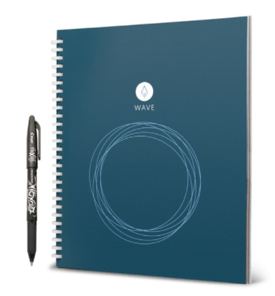I have piles upon piles of notepads of my handwritten notes filed in my desk drawer. Some of them date back quite far and yes, I still pull them out and refer to them. Sometimes, it takes some searching.
Over the years, I have often thought, “When is the notebook going to become smarter?” More people take notes on their computers or even smartphones. I’m not proficient at touch type and while I could, I feel it’s distracting to type in a meeting. There’s just something about a notebook. Maybe it’s a generational thing, but I just like to write my thoughts down on paper.
What if there was a paper notebook that you could write notes in, save them to the cloud and, when the notebook is full, easily erase the notes and reuse the paper? It sounds futuristic, but it’s here.
 While in a meeting recently with Marco’s Director of Information Systems, James Holweger, I saw him using a “smart” notebook. Knowing what a nerd I am, he showed me how it works. It was so cool that I ordered one on the spot and received it in the mail two days later (thanks Amazon Prime).
While in a meeting recently with Marco’s Director of Information Systems, James Holweger, I saw him using a “smart” notebook. Knowing what a nerd I am, he showed me how it works. It was so cool that I ordered one on the spot and received it in the mail two days later (thanks Amazon Prime).
This new notebook is called the Rocketbook Wave. As I watched the video on how it works, I felt like I was in a “Back to the Future” movie hearing about one of Doc’s crazy inventions. You erase the notebook by putting it in the microwave. Really.
I have not had to microwave mine, yet, but I know the technology works. It’s actually not the paper or the notebook that is “magical.” It’s the pens you use to write. Here’s a look behind the technology:
- Pen: The magic of the notebook starts with the Frixion pilot pens you use to take your notes. These pens are sold in almost any office supply store and are what makes the notebooks reusable. When heated, the ink turns clear.
- Notebook: This notebook, unlike most notebooks, is designed to withstand high levels of heat (of a microwave) to activate the erasing power of the pen technology. When the cover turns from blue to white in the microwave, the ink has been erased and the notebook is ready for reuse.
- Icons: The notebook is powered by an app that makes scanning and saving notes quick and easy. When taking notes, you check one of seven icons at the bottom of each page to tell the notebook where you want the notes saved. You can assign each of these symbols to your favorite file locations on Dropbox, Evernote, Google Docs, iCloud, Box, Slack, OneNote or an email address. This is the real advantage of the technology. The drawback is that the locations are not endless – yet – and users are limited to only seven folders. If you’re like me and organize files in more than seven places, you’ll need to eventually move some of the files to other folders.
- Image Processing: The app’s image processing tool automatically crops and enhances each scanned page. This makes it easier to view on digital devices and even print later if needed. Since the ink does not evaporate with heat, in some light old notes may be faintly visible. The image processing technology disregards them when scanning the new notes.
- QR Codes: Each page also includes a QR code that tells the Rocketbook app the page number of each scan to save the notes in the right order.
Most of the technology behind the Rocketbook is not new. What’s new is how the company packaged it all together to provide a productive, environmentally-friendly way to take, save and retrieve notes. I’m sure this is just the beginning of how technology will transform the traditional notebook.
I’ve talked before about the clear plexi-glass “notebooks” in development that will allow users to take notes and serve as a digital lens to documents, web pages and more. What makes the Rocketbook special is that it leverages technology while still remaining closely connected to traditional method of pen and paper.
Connect with a Specialist | Quick & Easy